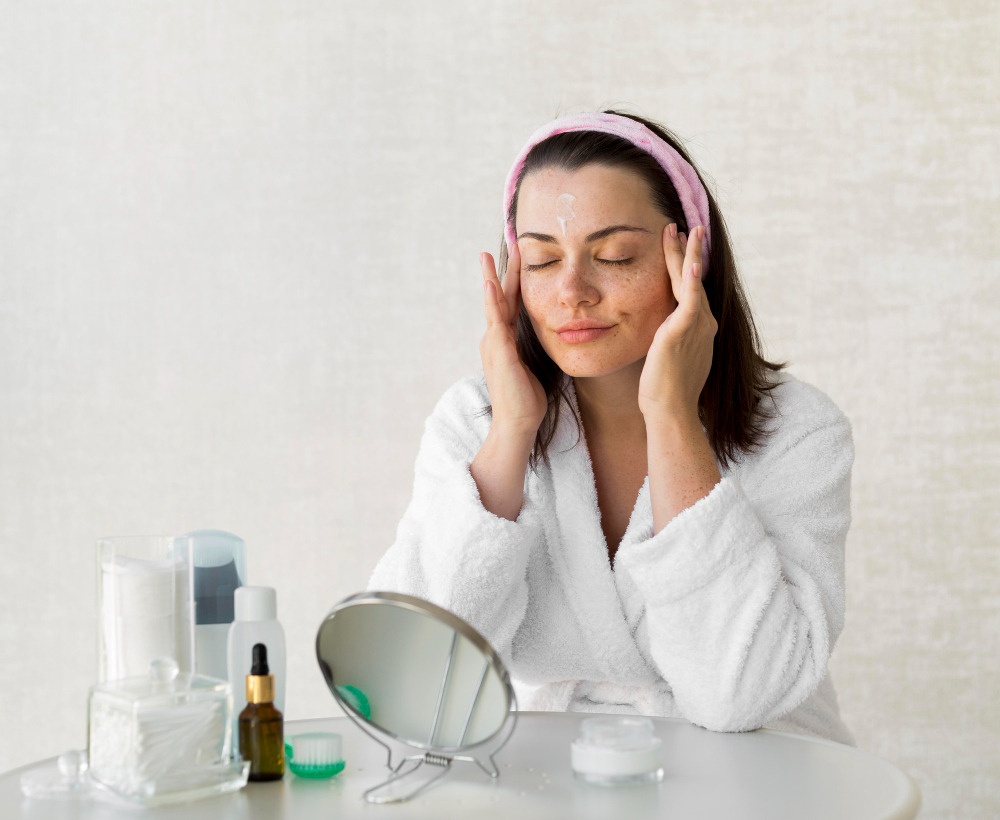/IN THIS ARTICLE
♥ Lactic Acid: A Skin care Solution for All Skin Types
♥ Normal Skin? No Problem!
♥ Dry or Dehydrated Skin: Hydration Heaven
♥ Acne-prone and oily skin: Say goodbye to breakouts
♥ Sensitive Skin: Tread Lightly
♥ Combination Skin: Balancing Act
♥ Mature or Aging Skin: Boost That Collagen!
♥ Uneven Skin Tone and Hyperpigmentation: Get Even
♥ Rosacea-Prone Skin: Proceed with Caution
♥ Teenage Skin: Clear Up and Calm Down
♥ Pregnancy and Breastfeeding: Play It Safe
♥ Unlocking the Truth About Lactic Acid: The Good, The Bad, and Its Surprising Uses
♥ FAQ
Lactic Acid: A Skin care Solution for All Skin Types
Lactic acid is a popular skin care ingredient, valued for its ability to gently exfoliate, moisturize, and revitalize the skin. But does the way you operate depend on your skin type? Let’s break down precisely how lactic acid works for distinct pores and skin sorts, and what you want to consider earlier than adding it to your ordinary skincare.
Normal Skin? No Problem!
If you have got everyday pores and skin, congratulations—you’re in the skincare candy spot. Most merchandise, together with lactic acid, work well for you. Lactic acid allows preserve your pores and skin’s texture and gives it a healthful glow by way of exfoliating away lifeless cells. For regular pores and skin, the purpose of lactic acid products with slight concentrations is normally around 5-10%. This variety is sufficient to keep your skin smooth and radiant without overwhelming it.
Dry or Dehydrated Skin: Hydration Heaven
Do you have dry or dehydrated pores and skin? Lactic acid may be your new great friend. Its hydrating homes attract moisture, making it ideal for pores and skin that’s thirsting for hydration. Look for products that prioritize moisture retention as well as exfoliation. Using lactic acid lotions or serums can help balance out dry areas and provide much-needed moisture.
Acne-prone and oily skin: Say goodbye to breakouts
Lactic acid could be a game-changer if you have oily or acne-prone skin. By lightly exfoliating the pores and skin, lactic acid helps unclog pores, which may significantly reduce pimple breakouts. For oily pores and skin, toners or spot remedies with a lactic acid awareness of around 5-10% are a good desire. For even better effects, consider pairing lactic acid with different acne-fighting ingredients like salicylic acid. The mixture can be a powerful weapon for your skincare arsenal.
Sensitive Skin: Tread Lightly
Sensitive pores and skin may be complex to manage, however, lactic acid—as compared to different alpha-hydroxy acids (AHAs)—is a milder choice. To keep away from inflammation, start with decreased concentrations (around 5%) and search for products in particularly designed for touchy skin. Always carry out a patch check earlier than making use of lactic acid to your face to make certain it’s secure on your skin.
Combination Skin: Balancing Act
When you’ve got a mixture of pores and skin, you’re juggling each oily and dry region, which makes finding the proper merchandise a chunk extra difficult. Lactic acid can deal with each of these problems via presenting balanced exfoliation. Consider using it in a serum or cleaner and adjusting how regularly you practice it depending on which areas of your face need more attention.
Mature or Aging Skin: Boost That Collagen!
As we age, collagen production obviously slows down, main to nice lines and less firmness within the skin. Here’s where lactic acid simply shines. It stimulates collagen production, making your skin appearance more impregnable and decreasing the arrival of exceptional lines. For mature skin, opt for merchandise with a barely higher lactic acid concentration (10-15%) to maximise anti-growing old blessings. Be certain to encompass lactic acid in a complete skin care habit for satisfactory consequences.
Uneven Skin Tone and Hyperpigmentation: Get Even
Dealing with hyperpigmentation or uneven skin tone? Lactic acid has returned. It works by inhibiting tyrosinase, an enzyme chargeable for growing dark spots, which enables promote an extra-even complexion. Depending on how extreme the hyperpigmentation is, you’ll need to look for products with an attention of 5-15%. For an effective brightening impact, don’t forget to combine lactic acid with other pores and skin-brightening dealers like nutrition C or niacinamide.
Rosacea-Prone Skin: Proceed with Caution
If you have rosacea, exfoliating acids may be problematic. While lactic acid is normally gentler than different AHAs, you’ll still need to be careful. Stick to decrease concentrations (around 5%) and search for formulas that consist of soothing substances. And, of course, continually patch-check first to see how your skin reacts. It’s additionally an excellent idea to seek advice from a dermatologist earlier than adding lactic acid on your habitual if you’re handling rosacea.
Teenage Skin: Clear Up and Calm Down
For young adults, lactic acid can be a fantastic ally, particularly whilst dealing with acne. Since it allows unclog pores, it’s a powerful aspect for those demanding breakouts. Teens need to look for cleansers or toners with decreased concentrations of lactic acid to keep away from overwhelming young, touchy skin. And right here’s an important reminder: continually pair lactic acid with exact sun safety. AHAs like lactic acid could make the pores and skin more touchy to the solar, so SPF is a must.
Pregnancy and Breastfeeding: Play It Safe
Lactic acid is usually taken into consideration for pregnant or breastfeeding girls, however, it’s usually smart to seek advice from a healthcare expert earlier than introducing it into your recurring. If accredited, stick to decreased concentrations and keep away from aggressive formulations. Safety first!
Lactic acid is a flexible factor that could advantage quite a few pores and skin kinds, from every day to sensitive to zits-susceptible. By deciding on the proper concentration and method, you may liberate its ability to convert your pores and skin—whether or not you’re seeking out hydration, anti-growing older results, or zits manipulation. Just bear in mind, begin gradually, patch-take a look at while wished, and adjust your utilization based totally on how your pores and skin respond.
Unlocking the Truth About Lactic Acid: The Good, The Bad, and Its Surprising Uses
Lactic acid—ever heard of it? It’s one of these matters that doesn’t get a whole lot of interest except you’re managing sore muscle groups after an excessive workout. But there’s greater to this little compound than just submit-workout aches. Lactic acid (or lactate, because it’s often called in the body) performs a key position in metabolism, powers components of your fearful system, and even jazzes up your favored fermented foods. Let’s dive into how this acid is both pal and foe, depending on the situation.
What Is Lactic Acid, and Where Does It Come From?
In simple terms, lactic acid is a derivative of electricity manufacturing on your body. When your cells burn gas for strength, they commonly depend upon oxygen to get the task performed—a manner referred to as aerobic respiration. But when oxygen runs low, like at some point of high-depth exercise, your frame switches to anaerobic breathing. This backup gadget creates lactate, an available strength supply however one with a piece of a reputation.
Lactic Acid and Your Muscles: The Workout Connection
Ever pushed yourself so hard at the gymnasium that your legs felt like jelly? That’s lactic acid (or greater appropriately, lactate) at works. Here’s how it goes down:
- The Build-Up Game: During intense exercise, your muscle groups demand extra strength than your cardio system can deliver. That’s while anaerobic breathing steps in, changing pyruvate (a metabolic intermediate) into lactate.
- Why It Hurts: If lactate manufacturing outpaces its elimination via the liver, it begins to accumulate in your muscular tissues. That build-up? It’s what gives you that burning sensation, cramping, and once in a while nausea. It’s also your body’s manner of telling you to take a breather.
While the pain frequently gets blamed on lactic acid, the real offender is probably microscopic muscle harm or inflammation from your workout.
The Silent Role of Lactate in Red Blood Cells
Not all cells in your frame can depend on oxygen to strength through. Take purple blood cells, as an example. They lack mitochondria—the tiny power factories in maximum cells—so they’re caught with anaerobic breathing as their primary energy source. In this manner, they’re constantly churning out lactate, which facilitates keeping them functional and prepared to supply oxygen for the duration of your body.
Lactate: A Secret Ally for Your Nervous System
Here’s wherein lactate gets truly exciting—it’s no longer only a by-product of power production. In your mind, lactate seems to play a starring position as a power source for neurons.
- Astrocytes to the Rescue: These glial cells, which surround neurons, can convert stored glucose into lactate. The neurons then gobble up this lactate for fuel, keeping your mind sharp and functional.
- Boosting Myelination: Lactate also helps the metabolism of myelin, the protecting sheath around your neurons, through the work of another kind of glial cellular referred to as oligodendrocytes.
In quick, lactate isn’t only an exercise buzzword—it’s a vital cog on your apprehensive machine machinery.
Lactic Acid within the Kitchen: A Culinary Star
Outside the frame, lactic acid takes on a whole new identification inside the international of meals. If you like the tang of yogurt, kimchi, or bitter beer, you’ve been given lactic acid to thank. Here’s the way it works:
- The Fermentation Magic: Certain microorganisms produce lactic acid at some stage in fermentation, giving those meals their signature sourness. It’s no longer just about taste—lactic acid additionally facilitates keeping these meals, making them remain longer.
Whether it’s adding zing to your favored snack or making sure your sourdough starter stays alive, lactic acid proves it’s a powerhouse in gastronomy.
When Lactic Acid Turns Dangerous: Lactic Acidosis
As useful as lactate may be, an excessive amount of it spells problems. Enter lactic acidosis, a condition in which immoderate lactate builds up inside the blood, throwing off your body’s pH balance. Here’s the way it happens:
- Root Causes: Anything from mitochondrial defects and irritation to hypoxia (low oxygen levels) or liver/kidney dysfunction can cause an overproduction of lactate.
- The Acid Problem: As lactate floods the bloodstream, it releases hydrogen ions to balance its poor charge. This makes the blood extra acidic—a dangerous shift that can lead to cardiac arrhythmias or different lifestyles-threatening complications.
It’s a stark reminder that balance is key, even for something as reputedly minor as lactic acid.
The Bigger Picture: Is Lactic Acid Friend or Foe?
It’s easy to think about lactic acid as the villain—it’s regularly related to muscle soreness and severe conditions like lactic acidosis. But that’s no longer the whole tale. In the right quantities, lactate is an essential part of our body structure. It powers our muscles, fuels our brains, or even makes the flavor of our meals better.
The takeaway? Lactic acid isn’t suitable or horrific—it’s about how your body makes use of it. When balanced, it’s an important best friend. When out of control, it’s a capacity threat. Like the maximum things in life, moderation is prime.
So the following time a person complains approximately “too much lactic acid,” you’ll recognize there’s greater to the tale. From workout to brain power to fermented ingredients, this humble compound does plenty more than we supply it credit for.
More Tips: Lactic Acid for Skin to Smooth Lines and Even Complexion
FAQ:-
1. What are the advantages of using lactic acid skin care?
- Gently exfoliates the skin, disposing of dead cells to show a smoother, brighter complexion.
- Helps enhance skin hydration by means of strengthening the pores and skin’s herbal barrier.
2. Can lactic acid be used on body skin, inclusive of elbows or knees?
- Absolutely! It smooths tough areas and brightens dull patches.
- Look for frame creams with lactic acid for smooth software.
3. How does lactic acid exfoliate the pores and skin?
- It breaks down the “glue” retaining dead pores and skin cells together, revealing brisker skin.
- This method promotes a radiant or even skin tone.
4. What precautions should I take when using lactic acid skin care?
- Always apply sunscreen for the duration of the day.
- Avoid combining with harsh exfoliants or active substances.
Related article: Lactic Acid Peel: A Gentle Game-Changer for Your Skin



Leave a Reply